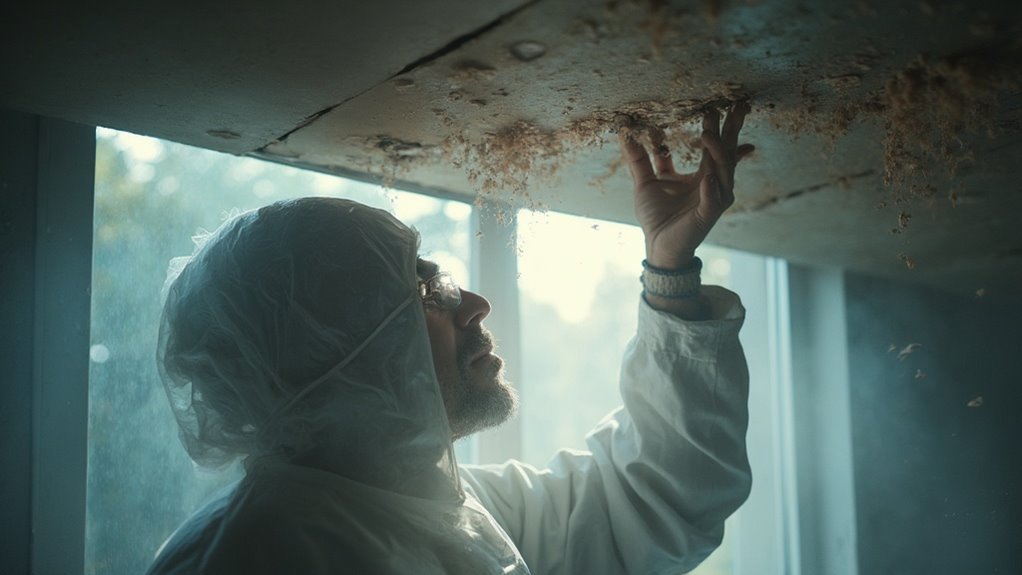Asbestos inspections are vital for protecting your health from harmful exposure. They start with a historical review, identifying potential materials like insulation and flooring. A thorough visual check follows, spotting any damage. Samples are taken and analyzed to confirm asbestos presence. Neglecting these inspections can lead to severe health risks, including lung cancer and asbestosis, from inhaled fibers. Regular monitoring guarantees early intervention and minimizes dangers during renovations. Complying with legal standards additionally prevents hefty fines and liabilities. To fully grasp the importance and process of asbestos inspections, you'll uncover more compelling insights ahead.
Understanding Asbestos Inspections

Understanding asbestos inspections is essential for safeguarding safety in environments that may contain this hazardous material. The process begins with a historical review and interviews to identify potential asbestos-containing materials, followed by a thorough inspection of accessible areas. You'll see that inspection protocols are meticulously designed to pinpoint areas where asbestos might be present.
During the visual inspection, you'll look for signs of physical damage or degradation in building materials, which could release asbestos fibers into the air. Identifying suspect materials—like insulation, floor tiles, and roofing—is critical for your safety. Once samples are collected, they're sent to accredited laboratories where laboratory procedures confirm the presence of asbestos fibers and assess their type and concentration. Asbestos exposure is linked to lethal diseases, highlighting the importance of these inspections.
The laboratory analysis informs your risk assessment, guiding recommendations for asbestos management or removal. After the inspection, you'll receive a detailed report outlining your findings, including the condition of identified materials and next steps. Adhering to these inspection protocols and laboratory procedures helps guarantee compliance with regulations and protects your health, making it vital to prioritize these inspections in any environment that may harbor asbestos.
Health Risks of Asbestos
Asbestos poses serious health risks that can have devastating consequences for those exposed. The inhalation of asbestos fibers can lead to conditions such as asbestosis, which scars lung tissue and results in chronic breathing difficulties. More alarmingly, exposure is linked to deadly cancers, including mesothelioma, which affects the lining around the lungs, and lung cancer, often resulting in a grim prognosis. Other cancers, such as those of the stomach and intestines, have been associated with asbestos exposure as well.
Several factors influence the risk of developing these diseases. Longer and more intense exposure increases your chances, as does the time elapsed since first exposure. If you have pre-existing lung conditions or smoke, your risk is even higher. It's vital to understand that symptoms can take decades to manifest, complicating early detection.
Public awareness about asbestos regulations is vital for promoting safety. Regular inspections and proper handling practices can substantially mitigate risks. Staying informed about potential exposure and undergoing health monitoring can help you catch early signs of asbestos-related diseases, ultimately protecting your health and well-being.
Asbestos Inspection Process

When conducting an asbestos inspection, it's essential to follow a systematic process to guarantee thoroughness and accuracy. First, you'll want to review historical records of the building to identify potential asbestos-containing materials. Next, perform an initial visual inspection of accessible areas, looking for any signs of asbestos. Engaging with building occupants, owners, or contractors through interviews can additionally provide valuable insights about materials that may contain asbestos.
Once you've gathered preliminary data, a detailed visual inspection is critical. Here, you'll assess materials for damage or degradation. If you suspect certain materials contain asbestos, use appropriate sampling techniques to collect samples safely. These samples should then be submitted to accredited laboratories for analysis, utilizing methods like Polarized Light Microscopy (PLM) or Transmission Electron Microscopy (TEM) to confirm accurate identification.
Throughout the inspection, adhere to established inspection protocols, documenting all findings meticulously. This documentation not only supports your findings but also helps in determining the next steps for managing or mitigating asbestos risks effectively. By following this structured approach, you can confirm a thorough assessment of asbestos in the building.
Importance of Regular Monitoring
Regular monitoring plays a vital role in managing asbestos risks effectively. By implementing a structured monitoring program, you can substantially improve the safety of your environment while ensuring compliance with regulations. Here are some key benefits of regular asbestos monitoring:
- Facilitates Early Action: Quickly address potential disturbances before they release harmful fibers.
- Identifies Damaged ACMs: Spot and repair damaged asbestos-containing materials before they pose a risk.
- Minimizes Exposure Risk: Recognize areas where asbestos may be disturbed during maintenance or renovation.
- Safeguards Occupant Health: Protect the well-being of everyone in the building from asbestos-related illnesses.
- Proactive Compliance: Stay ahead of regulatory requirements, avoiding legal liabilities linked to non-compliance.
Legal and Financial Considerations

Traversing the legal and financial terrain surrounding asbestos inspections is vital for property owners and managers. You must understand that mandatory surveys are required before any demolition or renovation, regardless of your property's age. If you skip this step, you risk facing compliance penalties, including hefty fines and potential civil litigation from affected workers or occupants. Significantly, past cases have seen fines soar to $100,000, alongside possible prison sentences.
In addition to immediate legal repercussions, the financial liabilities can escalate quickly. Non-compliance can disrupt your business operations, tarnishing your reputation and leading to costly lawsuits. You may incur significant cleanup and abatement costs if asbestos is found post-disturbance. Moreover, you're potentially responsible for medical assistance costs for those exposed to asbestos.
To mitigate these risks, verify that asbestos surveys are conducted by certified inspectors who follow the necessary regulations. By prioritizing compliance, you can safeguard your health and finances while maintaining the integrity of your property. Understanding these legal and financial implications is critical for effective management and protection against unforeseen liabilities.
Frequently Asked Questions
How Long Does an Asbestos Inspection Typically Take?
Imagine exploring a vast castle; your inspection duration could stretch from hours to days, depending on its size. Afterward, laboratory analysis takes 3 to 10 days, revealing the secrets hidden within its walls.
What Should I Do if Asbestos Is Found?
If you find asbestos, prioritize containment measures to prevent fiber release. Engage a trained professional for proper assessment and fiber mitigation strategies, whether that involves repair, encapsulation, or removal, ensuring your environment remains safe.
Can I Perform My Own Asbestos Inspection?
You shouldn't perform your own asbestos inspection because of DIY risks. Without professional expertise, you might misidentify materials or disturb asbestos fibers, increasing health hazards. It's safer to rely on trained professionals for accurate assessments and guidance.
How Often Should I Schedule Asbestos Inspections?
Asbestos regulations require regular reviews based on building age. Schedule inspections annually for older structures, or more frequently if materials show deterioration. Prioritize safety to guarantee compliance and protect occupants from potential health hazards.
Are There Any Specific Signs of Asbestos in Homes?
To identify asbestos in homes, look for visual cues like crumbling materials, textured popcorn ceilings, and specific floor tiles. These asbestos indicators suggest potential hazards, prompting further professional evaluation for your safety.
